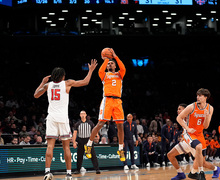Mind the gap : Increasing number of international undergraduates puts strain on support programs
UPDATED: March 23, 2012, 2:49 a.m. EST
CORRECTION: The minimum TOEFL score required by some colleges was previously misstated. Most colleges have a minimum score of 80, though some are raised to 85 or 90.
In a moment of scholarly zeal, one of Clint Tankersley’s foreign students divulged he had memorized Tankersley’s entire lecture.
‘One of the greatest honors they can bestow on a faculty member is to give them back exactly what a faculty member said in lecture,’ said Tankersley, a professor and associate dean at the Martin J. Whitman School of Management. ‘And I said, ‘So what do you think?’ which is not like some of the educational systems that they’ve grown up in.’
For international students at Syracuse University and universities nationwide, adjusting to the expectations of the American education system requires special transition programs and support services. But with the number of international undergraduates increasing each year, the leaders of some of SU’s support programs are feeling slightly strained as they work to ensure these students are equipped with enough language and culture skills to succeed in the classroom and beyond.
American universities are bringing in more international students as the bulk of college-bound students shifts away from the Northeast, and more families and governments abroad have the money to send their young adults to American universities.
At SU, the number of foreign undergraduates went from 347 in 2005 to 1,136 in 2011, an increase of more than 300 percent in six years, according to SU’s Office of Institutional Research and Assessment. Despite the increase, international students make up only about 10 percent of the undergraduate student body.
These are the schools with the greatest increase in foreign students from 2005 to 2011:
The School of Architecture saw a 505 percent increase, from 20 students to 101.
The College of Arts and Sciences saw a 384 percent increase, from 108 students to 415.
The L.C. Smith College of Engineering and Computer Science saw a 359 percent increase, from 29 students to 104.
Whitman saw a 336 percent increase, from 80 students to 269.
SU is still in the process of accepting next year’s freshman class, but admissions officials expect to have an increase of 20 to 25 international students in the incoming class.
All of SU’s centers and programs targeting foreign students try to incorporate two common trouble areas: English language skills and expectations at an American college. Knowing the differences among essay terms like ‘describe,’ ‘summarize’ and ‘analyze,’ group projects and original thought can trip up foreign students whose native education systems stress individual memorization and repetition, said Pat Burak, director of the Slutzker Center for International Services.
Burak recalled a theoretical architecture class in which 33 of the 35 enrolled international students were failing by mid-semester. By the end of the class, most of those students were able to pass. But Burak’s example reveals the difficulty many international students have in classes that demand original analysis and the very specific academic help SU’s foreign students need.
In most education systems outside the United States, students are graded solely on their performance on a final exam, Burak said. The expectation of attending every class, handing in weekly homework, book reviews or reflective essays is a marked break from what foreign students are used to.
‘You may get an A+ on the final exam, but if you haven’t turned in whatever else was expected, you’re not going to be held in high esteem by your teachers,’ Burak said.
The Slutzker Center offers a mentoring program for first-year students. Of the 365 new international students in fall 2011, 150 signed up: ‘A pretty good number,’ Burak said.
The center provides international students with everything from mediation in disagreements with roommates to language circles and visa help. Burak said the center’s staff is overstretched, and she has requested an increase in staff for several years. At the time she spoke, Burak had yet to see the university act on her requests.
SU’s English to Speakers of Other Languages program is also feeling the strain of increasing international undergraduate students, said both Burak and Margo Sampson, language coordinator for the program.
Sampson faces chaos at the start of each semester, as every first-year international student must test into an English proficiency level. During the first week of classes – when most professors are already assigning work – Sampson scrambles to create classes where there’s a greater need than expected, to hire more language faculty and to attempt to keep class sizes small.
As of now, ESOL classes are bordering too large for a language class, averaging at about 18 students each, Sampson said.
‘It would be wonderful if students could take an online exam before they arrive on campus,’ Sampson said. But this is impossible for the fear that unsupervised test takers will cheat, she said.
Nationwide, ensuring foreign applicants and students submit authentic and useful test results has also proved a problem on the TOEFL – the standardized Test of English as a Foreign Language that American universities use to evaluate prospective students’ English proficiency.
Sampson called the TOEFL a great exam for evaluating students, but said there’s no way of knowing how many times foreign students took it or how long ago it was taken.
Like any standardized test, there’s the worry that students cram and receive better scores than what reflects their actual language ability, said Gerry de Berly, senior associate dean and director of the English Language Institute. The institute runs out of University College and offers an intensive semester-long or yearlong English program before feeding foreign students into SU’s various schools and colleges.
SU recently raised its minimum TOEFL scores to better ensure incoming students have adequate language skills, de Berly said. Previously, most colleges had a minimum score of 65 out of 120. Now most schools have a minimum of 80 or higher, and some raised them to 85 or 90. The S.I. Newhouse School of Public Communications has the highest requirement of 100.
The rise in foreign students applying to American universities has raised concerns about application mills, which help students spoof their credentials, write college essays for them or fake high school transcripts. In tune with the national conversation about increasing international students, de Berly said some universities choose to vet their foreign student applications through a third-party company that specializes in detecting false application materials.
At SU, the admissions office requires that applicants’ transcripts come directly from the high school or previous institution, said Don Saleh, vice president for enrollment management. This offers a safeguard against fake applications, he said.
The admissions staff also compares TOEFL test scores to an applicant’s essay or does a Skype interview to check language proficiency, Saleh said. These precautions check if anything is ‘out of sync with everything else,’ he said.
At the University Senate meeting in February, professors also expressed their interest in the future success of international students through the Budget Committee’s report. The report praised the university for bringing more international students to campus, but advised that the university ensure undergraduate students’ language skills remain adequate.
Martha Garcia-Murillo, chair of the committee and a professor in the School of Information Studies, said international students promote diversity of thought on campus and may encourage American students to study abroad or learn about other cultures. The Budget Committee, she said, wanted to raise the point that bringing in more international students should not affect academic quality.
‘But how do we make sure they are prepared enough to succeed in the classroom?’ she said.
Support services without a foreign-student focus have also seen a great deal of use by foreign undergraduates.
In just a year, from fall 2010 to fall 2011, the Tutoring and Study Center saw an increase in the number of international student mentees. Only 2.7 percent of the students coming for help at the center were international in 2010, compared to 4.4 percent in 2011, said Jane Neuburger, director of the center.
SU’s Writing Center also serves a large number of international students, said Ben Erwin, administrator of the Writing Center. Erwin estimated that one-third of the students the center serves are international. They are often the returning students as well, he said.
Foreign students often come to the Writing Center with questions about attribution and citation, things that are taught differently in other countries, Erwin said. Notions of plagiarism are much more strictly enforced in America in comparison to cultures where repeating correct information verbatim is expected.
The Writing Center exemplifies how eager SU’s international students are to take advantage of whatever resources are available to ensure academic success. Erwin said his experience working with international students has been very gratifying, as he can follow their progress and watch them improve.
‘They know that they need to do well,’ he said. ‘They have a great desire to learn as much as possible.’
Published on March 20, 2012 at 12:00 pm





